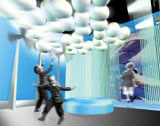Who says it’s child’s play?
James Knight takes a look at the children’s exhibitions market, to try to find out how designers cope with the needs of this demanding audience

Children are a fickle and volatile market to design for, particularly when creating physical experiences. Born in the computer age, they have high standards, short attention spans, and can be unforgiving, not to mention boisterous.
Yet young consumers are growing in importance and there is a real market for creating entertaining children’s experiences. How do designers deal with the demands of this exacting market? And are there fundamental differences between designing for children and an adult audience?
The £15m Children’s City, which opened earlier this year in Dubai, contains exhibits designed by UK consultancy O’Leary Prescott. ‘Children’s exhibitions are becoming more sophisticated,’ says partner Alex Prescott. ‘You shouldn’t dumb down the design process because you’re working with children.’
Imagination copywriter Dave Masters worked on the Our Global Garden exhibition at the Eureka! children’s museum in Halifax and agrees dumbing down is not an option. He highlights the need to consider a child’s perspective on aesthetics. ‘It’s tempting to think design for children doesn’t need an aesthetic component,’ he says. ‘They may not go round thinking, “That’s a nice birch finish”, but it doesn’t mean they’re not receptive to anything engaging or appealing.’
Aesthetically, most of Prescott’s considerations were practical rather than conceptual. The height of exhibits was lowered, and bold colours were used to attract young eyes. Interfaces had to be intuitive, decked with large, obvious controls – the designer can’t rely on children to read the instructions. Text was as large as possible, with capitals avoided. ‘Secondary text’ was added for adults to appreciate.
Our Global Garden was also intentionally ‘copy light’, says Masters. What was written aimed to give parents ammunition to deal with persistent questioning. The text employed easily-grasped metaphors rather than detailed technical explanation, although he admits that ‘there has been tension between how playful you could get before the science becomes questionable’.
Our Global Garden begins with the familiar – a town or country garden, depending on which floor you’re on – and moves through to the extraordinary, in the form of jungle, desert, oceanand ice-scapes.
The days of fake plastic trees and piles of imported sand are long gone, replaced by graphic and 3D elements, stereo soundscape collages and olfactory stimulation to indicate various regions – jungle, desert, ocean, urban. ‘Rather than creating a scientific facsimile of the world, we took an interpretative approach,’ says Masters.
A character-guide is increasingly being used to draw children into their environment. And this doesn’t mean a jobbing actor in a bear costume. Use of technology is now key to successful design for children. Imagination, in partnership with TV production company Collingwood O’Hare, developed a computer-animated character, Gordon the Gnome.
Going a step further, the Skyhigh chain of amusement parks, designed by Groupe Leçon, feature an animatronic, fully mobile family, the Stars. The family will ‘welcome the child, escort the child around, and wave the child goodbye,’ says Groupe Leçon design director David Lett.
The Skyhigh space-themed parks comprise a mixture of adventure, creative play and education. Total immersion in the environment is the key to winning over the visitor. ‘The story will start as soon as they cross the threshold,’ says Lett, and the experience extends to the toilets, which retain the space theme.
To cope with the low boredom threshold of today’s space adventurers, each venue has been designed so content can be circulated between them, adding novelty value to return trips. Combating boredom is key as most children’s attractions see tremendous early growth and then a steep drop-off as the next passing fad arrives, says Lett.
A recent trend has been the tendency to see children not just as users, but as creators and consultants. ‘Who are we as adults to dictate to them?’ asks Lett. Many of his team’s concepts have been adapted from drawings by primary-school children and Graven Images developed concepts for the Quarry Braey School in Glasgow in tandem with local schoolchildren.
A boon of the Children’s City project was the chance to project-test exhibits with children from local schools. After prototypes had been tried out, about 5 per cent of the content was changed says Prescott.
Testing isn’t just to see if the exhibits are enjoyable, it’s to see if they will survive or not. ‘Could it be pulled off the wall, eaten by a four-year-old or used to strangle a brother?’ were all questions regularly asked in design meetings of exhibit materials, says Masters.
Designing for young consumers isn’t child’s play. When creating experiences for children the challenges are considerable if the designer is to avoid the workaday. Perhaps the biggest consideration is not to underestimate the sophistication of the audience. Masters admits his team has been stretched almost as much as the exhibits will be. ‘You can’t go to your “That’ll do” bag,’ he says.
But the satisfaction of getting it right is huge and Masters says the project even reawakened the child in some of his team, ‘sometimes in spite of themselves’.
-
Post a comment



